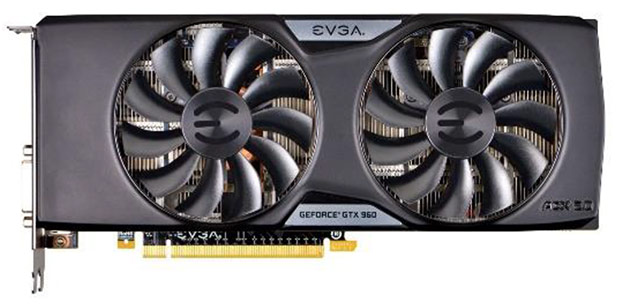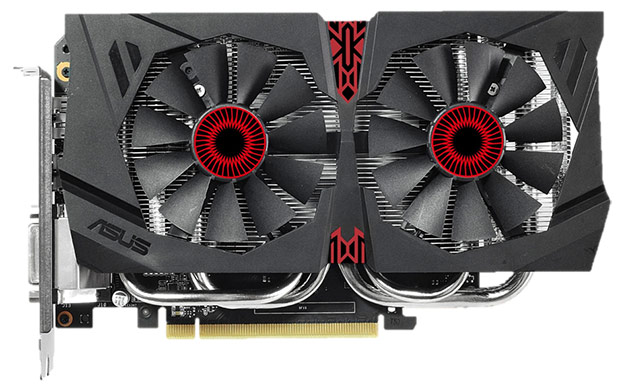NVIDIA GeForce GTX 960 Review With EVGA And ASUS
For the purposes of this review, we got our hands on a couple of retail-ready GeForce GTX 960 cards, the EVGA GeForce GTX 960 SSC and the Asus Strix GeForce GTX 960 OC. Both cards are custom solutions, with proprietary cooling each features a different PCB. First up, EVGA’s offering...
The EVGA GeForce GTX 960 SSC with ACX 2.0+’s main claim to fame is its custom heatsink and fan assembly. The dual-fan Active Cooling Extreme, or ACX, cooler features a large heatsink, which covers almost the entire front of the card. The heatsink is linked to the baseplate by multiple thick heatpipes and there is an additional heatplate mounted to the card’s PCB to help cool VRM and add rigidity as well. Though it may look similar to previous EVGA coolers, the heatsink used here leverages a new design, with straight heat-pipes, that’s more efficient than previous version. EVGA claims the new heatsink design can lower temps by an additional 5 degrees over their previous gen cooler, but the GTX 960 runs relatively cool in the first place.
The fans used on the ACX cooler also get some special treatment. According to EVGA the fan blade design offers superior strength to standard fans and the dual-ball bearings offer increased longevity over more common sleeve bearings. All told, EVGA claims the ACX cooler outperforms reference coolers, while also reducing weight and thickness. A feature new to this cooler is dubbed dBi (dB Noise Inverter). But that’s just a fancy way of saying the fans don’t even spin up until the GPU hits a temperature of 60’C. we should note that there is also a BIOS switch on the card that lets users bounce between a dBi BIOS and SSC BIOS, which alters the fan curve. When using the SSC BIOS, the fans will spin at all times, though the card is still nice and quiet.
As you can see, the EVGA GeForce GTX 960 SSC with ACX 2.0+ cooling is a dual-slot card, but it is slightly thinner than reference models. This particular SSC version is clocked at 1279MHz (base) and 1342MHz (boost) and its 2GB of GDDR5 memory clocked at an effective 7010MHz. And although the TDP of the card is only 120 watts, EVGA has outfitted it with an 8-pin power connector to provide some additional juice for overclocking.
Outputs consist of a single dual-link DVI output, 3 x full-sized DisplayPort outputs, and an HDMI connector.
The Asus Strix GeForce GTX 960 DirectCU II OC is a complete departure from EVGA’s offering, though they do have a few features in common. The Asus Strix GeForce GTX 960 DirectCU II OC uses a much shorter PCB, though it has been beefed up over reference models with a 5-phase VRM and custom cooling solution. It is factory overclocked as well.
The Strix GeForce GTX 960 DirectCU II OC features a dual-fan cooler, complete with a large heatsink assembly and backplate, which not only protects the PCB, but aids in cooling and adds some rigidity too. Like EVGA’s card, the Strix GeForce GTX 960 DirectCU II OC’s cooler will remain silent, and the fans won’t spin up at all until the GPU temperature creeps above the 55’C – 57’C range. The 5-phase VRM features high-quality chokes to eliminate the whining associated with some graphics cards, and additional caps to smooth power delivery. All told it offers a 30% higher voltage threshold, which should aid in overclocking, though the card has only a single 6-pin power connector.
As we’ve mentioned though, the Strix GeForce GTX 960 DirectCU II OC comes overlocked right out of the box. The card’s GPU has a 1291MHz base clock, with a 1317MHz boost clock and 7200MHz memory. In it’s out-of-box configuration, the Strix GeForce GTX 960 DirectCU II OC should be a touch faster than the EVGA card above, but both had plenty of overclocking headroom as you’ll see a little later.
The outputs on the Asus card were identical to EVGAs, and consist of a single dual-link DVI output, 3 x full-sized DisplayPort outputs, and an HDMI connector.











